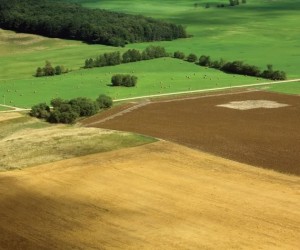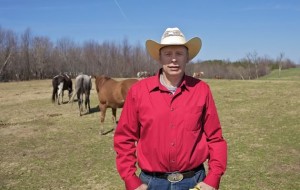The Battle Shifts Gear
- Details
- Published on Tuesday, 09 April 2013 01:45
- Hits: 2472
With the mega quarry shelved, opponents say they’ll keep fighting until they get permanent protection for farmland in Ontario.

Before the fight to stop the mega quarry attracted national attention, it began in local farm kitchens such as the Armstrongs’. Now snug in his mother’s arms at the table with three generations of his family, baby Derek attended his first anti-quarry rally when he was just three weeks old. He is the latest addition to a family that first tilled soil in the area in 1853, and he represents the hope for the future as his grandfather Ralph Armstrong and other activists turn their attention beyond Melancthon to secure permanent protection for prime farmland and source water for Derek and generations to follow.
On a cold February evening in Honeywood, at the Taters Not Craters party held to celebrate the demise of the mega quarry, a cheer erupts when three-week-old Derek Martin is held aloft like a newborn king. As the grandson of Redickville farmers Ralph and Mary Lynne Armstrong, tiny Derek represents the seventh generation of the family who took up farming here in 1853.
The Armstrongs were among the original few farmers bordering the proposed Melancthon mega quarry who refused to sell to The Highland Companies and formed the North Dufferin Agricultural and Community Taskforce (NDACT) to oppose it, trading lottery-sized buyouts for a new life of activism. So it’s fitting that the family’s newest member should be here, to celebrate the protection of his home turf and water.

Clockwise from left: Kate Martin with Derek (at six weeks), Steve Martin, Mike Watson, Peter Watson (5), Nicholas Watson (1o), Ralph Armstrong, Mary Lynne Armstrong, Anna Armstrong, Margaret Armstrong, Sarah Watson. Photo by Pete Paterson.
On November 21 The Highland Companies, with little explanation or fanfare, withdrew its application to build a 2,316-acre quarry in Melancthon and cancelled its ambitions to rebuild the railway between Orangeville and Owen Sound, noting there was insufficient community and government support to continue. A significant understatement, considering that just a month earlier the Soupstock anti-quarry protest at a public park in Toronto had drawn a crowd 40,000 strong.
Highland’s final tweet, October 19, was “We’re listening, Soupstock attendees.” But nobody expected the announcement that the quarry was dead, or the news that John Lowndes, the engineer from Alton who had launched the scheme, was finished with the company.
The company hastily unplugged its PR machine, pulling down its Melancthon Quarry website and replacing HighlandCompanies.ca with a blank page. Calls to the company’s media hotline went unanswered. And Lindsay Broadhead, vice-president of Hill+Knowlton Strategies in Toronto, said her PR firm is “not really” working with Highland anymore, although she insists the company would have nothing more to say: “Everything that was stated at that time holds. At the end of the day they’re going to continue farming.”
With that, the dragon retreated – without a peep to allay the many fears that it will re-emerge with new plans to make money from wind, water, rock or rail.
“We have to remain vigilant because the laws haven’t changed, the same people own the property, and the limestone is still there. We’re still at risk,” says local resident and NDACT volunteer Norm Wolfson. Many believe that if Highland – or any company it sells to – were to apply for a smaller quarry, it would likely win approval under current legislation.
So NDACT’s party at the Honeywood arena on February 16 was half celebration for what NDACT’s chair Carl Cosack calls the completion of job one. But it was at least as much a pep rally for act two: seeking permanent changes to two key documents governing aggregate development in Ontario – the Aggregate Resources Act (ARA) and the Provincial Policy Statement (PPS) – so class 1 to 3 farmland and source water areas province-wide are off limits to quarrying forever.
“We want to change the policy regime in Ontario so that no other community ever faces the nightmare that Melancthon faced,” says Faisal Moola, the Ontario director of the David Suzuki Foundation.
NDACT has enough money to carry on without further fundraising. “So we’re going to keep the pedal to the metal and keep pushing,” says Cosack. He believes they can finish the job in one, maybe two years.
NDACT, along with the David Suzuki Foundation and others in the broad alliance of environmental, First Nations, and food and farming groups that came together under the banner “No Mega Quarry” have remobilized around the slogan “Food and Water First.” Expect to see the slogan on more lawn signs, as well as possible reincarnations of the massive autumn Foodstock and Soupstock happenings.
NDACT members insists it’s a small thing to ask: a simple legislative change that places prime farmland off limits to aggregate development. But the request has massive implications: sweeping changes not only to aggregate legislation and current industry practices, but also to the underlying land use policies that drive aggregate demand – our addiction to urban sprawl.
Where do we get a billion tonnes?
The Melancthon quarry would have provided a billion tonnes of limestone – enough in a single quarry to fuel the GTA’s building boom for another decade and a half.
“Before Melancthon we already had a supply crunch,” says Moreen Miller, the aggregate’s industry spokesperson as CEO of the Ontario Stone, Sand and Gravel Association (OSSGA). She points out that the government’s 2010 State of the Aggregate Resource in Ontario Study (SAROS) predicted supply shortages in the GTA within a decade. “We’re five years into that 10-year period now. In that five years the provincial government and the Ontario Municipal Board have turned down licences for 140 million tonnes of high-quality stone supply. There is definitely a supply shortage coming. There’s no question.”
Environmentalists cite contradictory evidence that there is enough aggregate reserve in licensed pits, especially if demand is trimmed through conservation and recycling. The true state of the supply is unclear, in large part because the PPS works against any clarity on the issue by directing aggregate development to proceed with no consideration of need or “any type of supply/demand analysis.”
What is certain about aggregate supply, says Ric Holt of the province-wide group Gravel Watch, is that “right now, we’re using it at such a phenomenal rate that it won’t keep up indefinitely. The cost of gravel is somewhere around eight dollars a tonne, so if I’m getting some for my driveway, I might as well get 10 tonnes because I have to pay for the truck. That’s the way construction has been going in Ontario.”
The Toronto skyline bristles with construction cranes, the suburbs march on.
The SAROS report recommended mega quarries as the supply solution and Melancthon was supposed to be the aggregate pot of gold. Its demise puts pressure back on communities like pit-riddled Caledon, the GTA’s old friend-with-aggregate-benefits. There, Blueland Farms is expected to reapply any day to mine below the water table at the old McCormick Farm property on Heart Lake Road.
REDC (People for Responsible Escarpment Development Caledon) took a cynical view of the Melancthon win, writing on their website:
“What’s the lesson here? Massive large-scale, single-site development gets massive public pushback. But the tried and true methods of large-scale aggregate mining continue to work: Start with a licence to mine a few hundred acres. Add to the operations incrementally through amendments to existing licences. And it’s under the public radar. The result is the same – the creation of colossal sites that eventually exceed the acreage of a proposed Highland Farms development and keep going.”
REDC notes that Caledon’s 3,800 acres of licensed quarry lands already surpass Melancthon’s proposed 2,316. Add proposed pits and unlicensed lands already owned by gravel interests in Caledon and the number jumps to 4,600. A satellite photo shows a lunar garland of bare grey pits and man-made lakes in the heart of the Greenbelt, what a 2007 study by the Social Sciences and Humanities Research Council found to be “the largest series of gravel pits in North America.”
It’s a classic case of the frog in the pot – we accept incremental change. Had all 3,800 acres come forward in a single application, as in Melancthon, would it ever have been approved? REDC is trying to change the dialogue for future projects. “Size and cumulative impact need to be addressed,” writes REDC president Christine Shain.
Meanwhile, in January Arbour Farms reapplied for its pit in Mulmur on Airport Road near County Road 21. Arbour’s company spokesperson called their 103-acre proposal “the fly on the elephant’s backside” compared to the mega quarry. By the time you read this, the ARA-mandated 45-day window for public comment on the Arbour Plan will have closed.
The primary objections to both Arbour Farms and the Heart Lake Road pit are not about farming at all, but the impact of gravel trucks on local roads. Ironically, if all the local options are rejected, gravel will be travelling farther to feed the GTA’s 60-million-tonne-a-year appetite for aggregate.
“The further-from-market options are increasingly troublesome,” says OSSGA’s Miller. “We can’t even get our communities to work every day, let alone put more aggregate trucks on the road. Are we willing as communities to balance that additional load in terms of greenhouse gases and traffic?”
Is agricultural land renewable?
The supply crunch, the distance from market – these are among the reasons that industry fiercely opposes calls to ban aggregate mining on prime farmland.
“I don’t think it’s a realistic request,” says Miller. “We already are excluded from most land uses. Class 1 to 3 farmland – it’s virtually all we have left – and we’re asking that land to do a lot, feed a lot of people, or produce aggregate, or produce wind or allow people to live on it. Going through lists of land uses and saying yes, no, maybe. I don’t see that as a long-term sort of comprehensive, balanced approach. The folks from NDACT have said there’s lots of material available elsewhere. We’d like to know where that is.”
Miller would prefer to see the aggregate industry continue to be recognized – as it is in the legislation today – as an “interim land use,” one that can dig up farmland under the assumption that it will one day put it back.
“From the perspective of our industry, agricultural land is renewable,” says Miller. “The people in Melancthon didn’t get a good taste for that.” It’s hard to believe The Highland Companies ever could have made good on its preposterous plan to farm Melancthon’s aquatic depths (which would have required round-the-clock pumping – forever), and one gets the sense that the industry at large wants the company’s bravado claim forgotten.
Miller says in Wellington County there are quarry sites where farmland has been rehabilitated and even improved – from class 5 to class 3, for example – over a period of not decades, but just two or three years.
Nevertheless, the aggregate industry has a poor track record in Ontario. From 1995 to 2005, it only rehabilitated one acre for every 2.3 it dug up. Still, it wants another chance with the land that remains – prime farmland included.
Farmland in crisis
Food and Water First activists say the farmland that’s left is too precious to risk on more promises. They are working to get the word out that Ontario’s $33 billion agri-food sector is the province’s biggest economic driver – greater than the auto sector. They report the sector employs 250,000 and is growing at 10 to 20 per cent, but depends on a tiny and rapidly shrinking land base.
Only 5 per cent of Canada’s land is suitable for agriculture and only 0.5 per cent is class 1 farmland. In the three decades from 1971 to 2001, Canada paved over prime farmland at a rate of one Melancthon mega quarry every two weeks. And it continues. A David Suzuki Foundation study found that development in the “whitebelt” (undesignated land) around the Golden Horseshoe is on track to consume natural lands twice the size of Mississauga in the next 30 years.
All that development will require aggregate. And until we quell our crushing appetite for stone, implementing the kind of long-term changes that render another mega quarry unnecessary, the issue of aggregate supply will pop up again and again.
“Today, most of Canada’s towns and cities are at a crossroads,” wrote David Suzuki in a late-February op-ed piece that broadcast the Food and Water First message nationwide. “Our political leaders and citizens must seize this opportunity to embark on a visionary path to grow our communities smarter and protect Canada’s near-urban nature and farmland.”
People power
If such wholesale change to land use in Ontario seems unlikely, it’s worth remembering where the No Mega Quarry movement stood just a few years ago.
The giant pit in Melancthon looked like a fait accompli. Legislation lined up in its favour. The province needed the aggregate. The land fell outside such barriers to development as the Niagara Escarpment, Greenbelt and Oak Ridges Moraine. The rock could even be shipped out by eco-friendly rail. Unlike hotly contested Caledon to the south, there was a scant population in Melancthon to oppose it – and who else had even heard of the place? One can imagine John Lowndes rubbing his palms over a PowerPoint presentation in a Boston boardroom.
Then along came YouTube and Twitter and the Arab Spring – social media activism’s coming out party. Foodstock, on a Sunday afternoon in October 2011, was the farm-field equivalent of inviting the entire planet to a block party on Facebook, physically putting enough voting bodies into a potato patch to get it on the political map. The organizers are convinced something has shifted in the public consciousness, that a policy window has opened – a golden opportunity to reform legislation that protects the sources of local food and clean water.
“Timing is just as perfect at it’s going to get,” says Cosack. Until prorogation last fall, the Legislature was in the midst of reviewing the ARA, and the Ministry of Municipal Affairs and Housing is currently leading a review of the PPS. (The public comment period has officially ended, but the ministry says further comments emailed to This email address is being protected from spambots. You need JavaScript enabled to view it. will still be considered.) Our new premier Kathleen Wynne is also the minister of agriculture. Before winning the position, she met personally with Food and Water First activists.
At the Taters Not Craters party, sometime after the appearance of baby Derek, Guelph agriculture professor Rene Van Acker summed up this political moment in a speech: “There is a wave building of a food culture in this country that links urban people to the farm, and this is an example of how that’s going to drive legislation.”
Dave Vander Zaag, the potato farmer who hosted Foodstock’s 28,000 visitors, saw this phenomenon for himself in the form of a long thread of traffic leading out of the city right to his doorstep.
“It was like something out of the movies – cars as far as you could see and people just streaming across the field coming in. I had a friend who said it brought tears to her eyes. ‘People finally get it,’ she said. ‘People finally realize how important this is.’”
By Tim Shuff
Published in In the Hills Spring Edition, March 31, 2013






